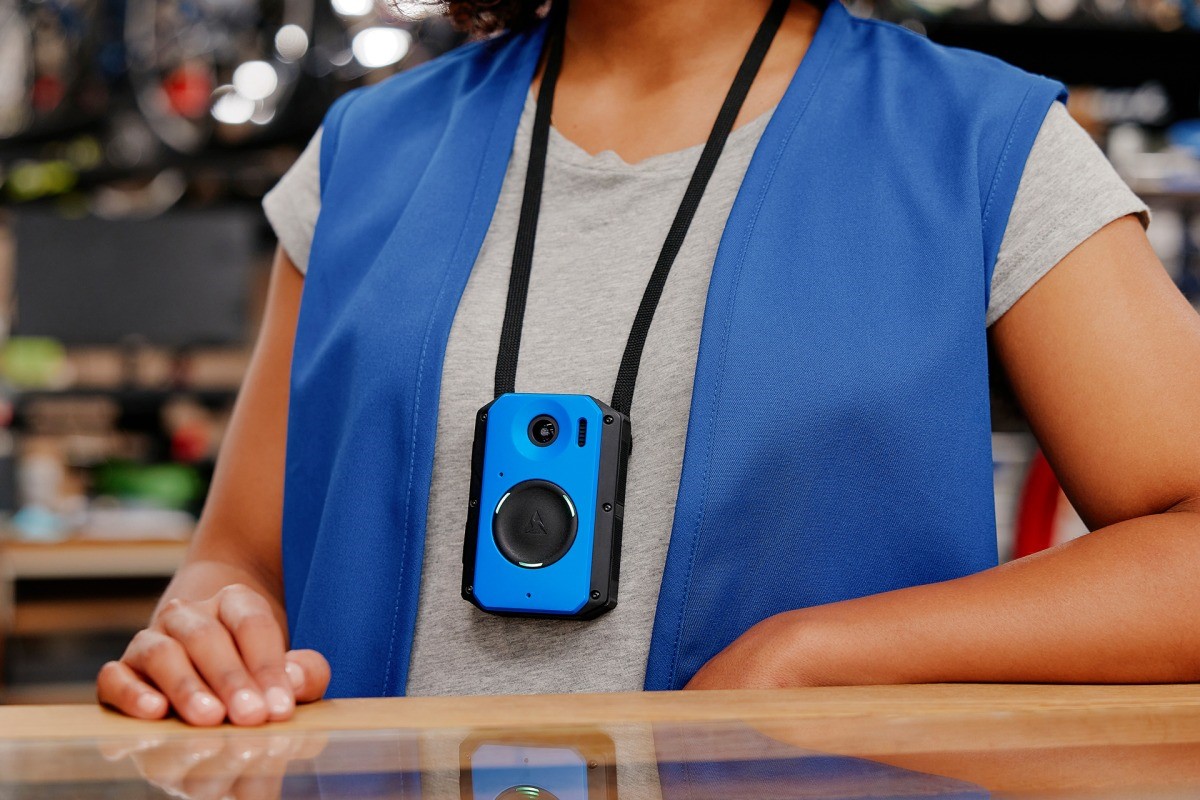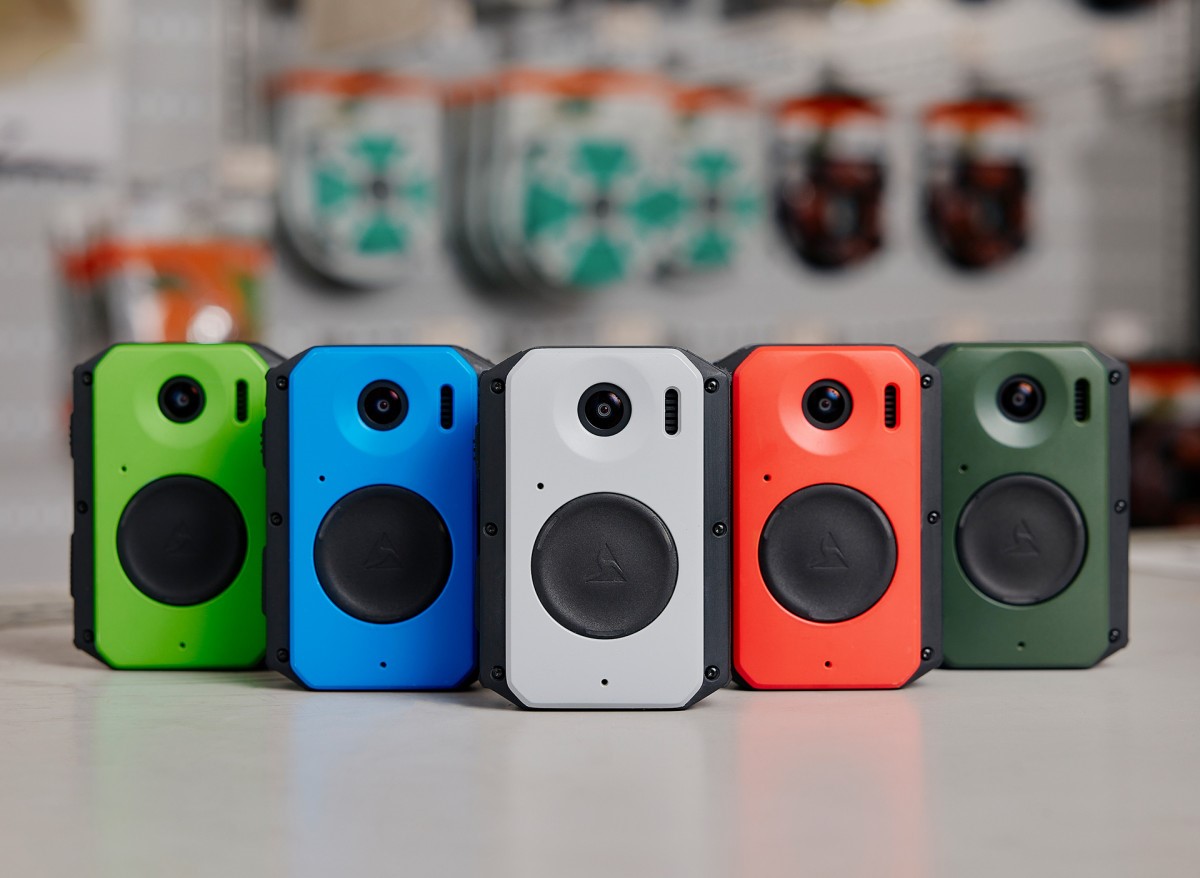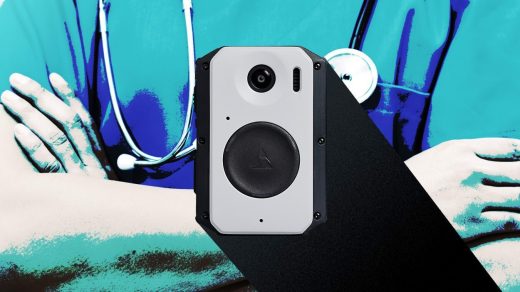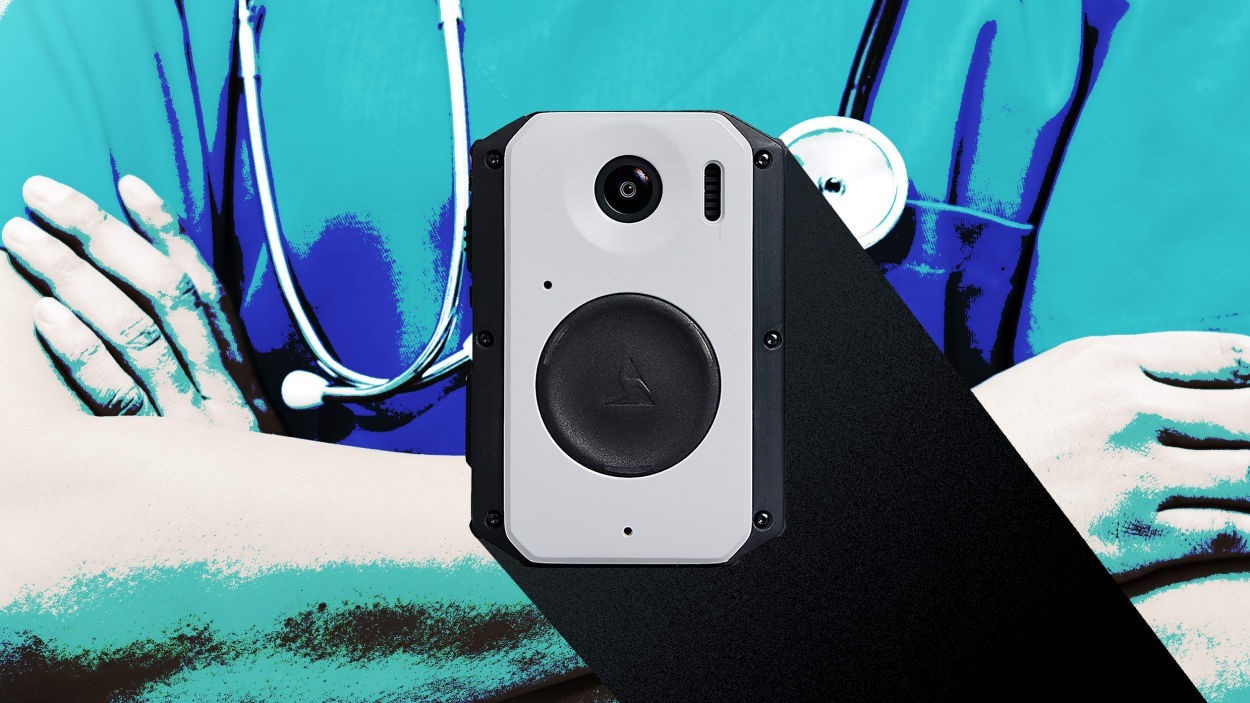The thorny push to put body cameras in hospitals and stores
Once, body cameras were attached only to cops, part of an effort to produce more evidence, de-escalate tense situations, and reduce force and abuse. The jury is still out on how effective they are, but the technology is spreading fast, and not just within policing. Increasingly, other sectors have adopted the cameras, and nowadays you might spot bus drivers, paramedics, sanitation workers, and even hospital and retail employees sporting the cameras. The idea is mostly twofold: to enforce accountability on its wearer’s part, and to discourage the on-the-job abuse that’s been surging against frontline workers even before the pandemic began.
At least that’s how Axon, the maker of Taser weapons and police equipment, is pitching its new line of body cameras, designed especially for employees in retail and healthcare.
The new device, the Axon Body Workforce, which is slimmer than the company’s black police cameras and comes in a range of bright colors, “marks a new chapter in body-worn cameras, built to address the workplace violence affecting frontline workers,” says Axon CEO and founder Rick Smith.
Body cams of all kinds have begun to appear on hospital and in-store workers in the U.S., following roll-outs in Australia and the U.K., including at the National Health Service and retail giant Tesco. Since 2020, Axon says its cameras have been trialed by “some of the largest healthcare networks and global retailers,” including Georgia-based Piedmont Healthcare, by Christus, a Catholic nonprofit system in Texas, and by Portland-based Legacy Health. Most workers wearing its cameras are security personnel, but trials are underway with non-security healthcare staff and in-store retail associates, the company says.
Body camera companies say the devices can help reduce abuse, diffuse tense situations, provide more evidence to identify and prosecute assailants, protect organizations from fraudulent use-of-force and misconduct claims, and decrease litigation costs. For Axon, formerly known as Taser, it’s an extension of a futuristic vision of technologies that can reduce police paperwork, reduce shootings, and even de-escalate confrontations before—or without—the police.
Mike Shore, Axon’s vice president of Enterprise, says the camera was part of a mission to “help de-escalate unfolding threats, which may not always involve law enforcement or may unfold before a law enforcement response.”
For example, he says, during an in-store trial “one retail associate experienced a shopper putting several items in their personal bag, and when the associate noted they were wearing a camera the shopper placed the items back in the store and left.”
Retail and healthcare also represent vast new markets for companies like Axon. A 2022 estimate by analytics firm Omdia put the size of the body-cam market at $1.5 billion, a number it says could more than double by 2027. Just around 11% of the body cam market is estimated to be for non-police workers, a proportion it expects to grow to more than triple in five years. The size of the U.S. healthcare and retail industries alone—with 3.2 million registered nurses and over 15 million in-store employees respectively—suggests a healthy stream of potential revenues.
“The non-police market for body-worn cameras has become particularly important for market growth in recent years as the police market itself has matured,” says Paul Bremner, a public safety analyst at Omdia.
A number of smaller body-camera companies have already begun pushing beyond policing. Axis Communications, a Swedish subsidiary of Canon, released a camera last year targeted at retail, healthcare, and transportation workers. Motorola Solutions also sells body cameras aimed at commercial employees, and London-based Reveal Media has a camera with a front-facing screen “designed to calm down tense situations within the healthcare sector.”

In recent years, Axon has also sought to boost adoption in hospitals with generous promotions, like the ones it’s previously offered to police agencies. In 2022, it began offering free cameras, Taser discounts, and a 60-day trial of its evidence management platform to healthcare customers if they signed up for an “Axon Healthcare Security” bundle. The fund for the promotion grew to $40 million last year.
Axon declined to share prices for its new camera, but a model popular among police can cost around $800, along with $600 per year for a basic Evidence.com subscription with 100 GB of cloud storage; additional plans offer AI tools like transcription of audio and redaction of sensitive information like faces and private data. The company also offers “different pricing models to meet organizations’ needs,” Shore says. “We don’t want cost to be a barrier for public safety.”
So far, however, there is scant independent data on the impact of body cams in hospitals, healthcare facilities, or stores. In a 2022 comprehensive review of body-worn camera (BWC) use in mental health facilities, researchers at King’s College London found “there is limited evidence for the efficacy of BWCs to control and manage violence within mental health inpatient wards.” In its own trials, Axon says one U.S. retailer that deployed its cameras saw a net 53% reduction in “incidents,” while another reported 47% of active incidents being effectively de-escalated after activating recordings on the camera. (Fast Company could not independently verify these numbers.)
Body cams have also been touted as a way to enhance accountability and transparency in healthcare. In a Boston Globe essay last year, Amanda Joy Calhoun, a psychiatry resident at Yale School of Medicine, proposed that doctors wear body cameras, not to protect them but as a way to stem deep-seated racism in the healthcare system. “Body-camera footage is linked to reduced police brutality, and cameras in schools are effective against bullying,” Calhoun wrote. “Monitoring the actions of individuals can result in self-checking behavior. If we want to see a reduction in poor health outcomes for Black patients, we must hold health care professionals accountable in real time.”
But the impact of body cameras on policing isn’t so clear. A review by the Department of Justice of 70 studies of police body-cam programs in 2022 found the devices had “no consistent or statistically significant effects . . . on use of force, assaults on officers, officer-initiated calls for service, arrests, traffic stops and tickets, and field interviews (i.e., ‘stop and frisk’).”
The cameras can be costly too, and not just in terms of money. The serious privacy risks they pose, both for the people being filmed and those doing the filming, only grow more complex in sensitive places like homes or around victims of crimes. Collecting body camera videos in healthcare facilities poses new dangers, privacy advocates warn.
“It’s hard to overstate how much of a privacy nightmare the idea of equipping healthcare workers with surveillance cameras is,” says Evan Greer, director of the advocacy group Fight for the Future. “These cameras, which often lack proper security protocols and oversight, would be recording some of people’s most intimate and private moments, and that footage would be accessible by potentially numerous hospital employees, not to mention hackers, criminals, and potentially law enforcement agencies.”

Despite the sensitivity of patient data, hospitals have had a poor track record of safeguarding it, and are frequent targets of ransomware and other cyberattacks. In November 2022, for instance, Legacy Health, the Axon camera customer, revealed that a former employee had stolen patients’ personal information, including dates of birth, diagnosis and/or treatment information, and social security numbers. (A spokesperson for Legacy declined to comment on whether body-camera video was also taken, or to share any details about its body-camera policy.)
“The best way to prevent violence in health care settings would be to listen to healthcare workers and ensure proper levels of staffing, training, and funding for safety protocols,” Greer says. “Exponentially increasing surveillance in healthcare settings will make everyone less safe, and will specifically endanger people who already face systematic injustice and discrimination.”
Cameras could adversely impact health outcomes, Marc Siegel, a clinical professor of medicine at NYU Langone Health, wrote in an op-ed last year. “We can’t deny mistreatments on both sides,” he wrote, but “an intimate encounter where a patient reveals secrets that are essential for care and cures is one that needs to be free-flowing, not scripted based on fear of retribution.”
With a far more intimate perspective than on-the-wall CCTV cameras, body cams also require healthcare facilities to navigate a legal thicket of privacy rules, including HIPAA and other federal and state laws that protect people, for instance, inside their hospital rooms. Axon has sought to address these concerns in a white paper and an example body-camera policy, a variation on the advice it provides to police agencies.
“Police are a debatable case,” says Jay Stanley, a senior policy analyst at the American Civil Liberties Union, “but we don’t think it would be a good thing for body cameras to become widespread—especially in healthcare, where the potential privacy invasions are extreme. Who wants their doctor wearing a camera? [Or] to live in a world where half the workers in America are wearing a camera?”
As with police cameras, Axon argues the benefits of cameras in shops and healthcare facilities are worth the costs, especially given the threats frontline workers now face.
The data on retail crime can be slippery, but in 2022, 81% of respondents to a survey by the National Retail Federation said U.S. retail criminals had grown more violent. A separate report by the Council on Criminal Justice (CCJ) last November studied 24 major U.S. cities and found that while store assaults decreased by 7% in the first half of 2023 compared to the first half of 2022, they were 8% higher than the same period in 2019.
Hospitals and clinics are also among the country’s most dangerous places to work. A 2021 American Federation of Labor and Congress of Industrial Organizations report on worker safety found that rates of workplace violence in healthcare and social assistance are among the highest of any profession, and have nearly doubled since 2010, a trend that likely continued upward during the COVID-19 pandemic. A 2022 analysis by Press Ganey, a healthcare analytics company, found that on average, two nurses are assaulted in the U.S. every hour.
In one incident last July, staff at a Legacy Health hospital in Portland grew concerned about a man who was causing trouble in the maternity ward, and called police, worried that he might try to abduct his partner’s newborn; he soon opened fire, killing a hospital security guard named Bobby Smallwood. At the time, Smallwood was wearing his Legacy-issued Axon body camera. “Jesus, forgive me,” he could be heard moaning in the footage, The Oregonian reported. “Ohhh, I’m dead.”
A rise in violence against healthcare and retail workers in the U.K. has helped make body cameras standard among some hospital staff and in-store workers across the country. In 2019 the National Health Service (NHS) pledged to invest £8 million to pilot test body cams as a way to enhance staff safety and assist in prosecuting violence against staff. In 2020 Tesco, Co-op, Sainsbury’s, and Waitrose all began issuing cameras to their employees.
Still, another supermarket said recently it would not be issuing body cameras to staff over privacy concerns. “I don’t really want to get to a world where you sit down and everybody’s photographing everybody else for whatever action they take,” Asda chairman Stuart Rose told The Grocer in September. “That’s not a good place to be, but we do have to be careful about how our staff are exposed to dangers.”
Paddy Lillis, General Secretary of USDAW, a union representing thousands of U.K. shopworkers, told Fast Company that “there is no doubt” that cameras can be effective at deterring in-store violence. But, he says, “to act as a deterrent to would-be attackers, the public must be fully aware they are in use and there must be a police response where incidents do occur.”
The camera deployments haven’t impressed everyone. On a worker forum for a U.K. chain store, reviewed by Fast Company, privacy was among a number of concerns raised by staff who had been told to wear the devices. Some worried the cameras—when they were charged and working—could be used to monitor and track employees themselves, or that they could aggravate already-irate customers. Some called the cameras an insufficient safety measure, the result of cost-cutting plans to leave stores with more surveillance technology but fewer actual security guards.
“It’s so they can cut down on staff, if you wear headsets, cameras . . . you can be 1-1 or have less staff covering area as the tech acts as their backup (in theory) however we all know in practice this isn’t the case,” wrote one in-store worker. Another wrote: “Having been attacked wearing one in the past because I was wearing one I do not feel ready to put one on again, but maybe in time.”
The spread of body cameras mirrors a larger shift toward digital public safety: Old CCTV signals have given way to body-camera live-streams, now combined on the cloud and in fusion centers, scanned with AI to identify people and behavior in real time. Add to this the profusion of video generated by a wave of home and personal security technology, apps like Citizen and camera makers like Amazon’s Ring and Fusus; and social media, and the abundance of data we share, often without our true consent. And now, a decade after Google Glass invented glassholes, new wearable computers are coming, the latest grasp at a future when everyone’s wearing a computer (and a camera).
Ring said last week it would stop letting police request user videos through its app without a warrant, following years of criticism from privacy advocates over its close relationships with police departments. In some localities the company teamed up with police to help promote the cameras within neighborhoods. The increasing public-private tie-ups in public safety, and spread of video and AI, and the ability of virtually anyone to report behavior they perceive to be suspicious: It contributes to a culture of surveillance where expression is subtly and not-so subtly stifled, and ethnic and other kinds of profiling are standard.
In law enforcement, body-camera video has proved to be a mixed blessing for police and prosecutors, but their record when it comes to reducing police violence and ensuring accountability is less clear. Absent any overriding laws, so much depends on how the cameras are used and policies are designed. In both minor and highly controversial cases, police departments often keep body-cam footage out of public view. It’s significant that the close-up video of Floyd’s murder set off a global movement, but it was a teenager’s cellphone, not a body camera, that captured it. As he wrestled Floyd to the ground, the lead officer’s body camera fell off, and his and the rest of the officers’ body-cam videos were withheld from release for months.
Whether or not police body cams are serving the public interest, the public is often paying the bill, and it’s a big bill, and big business. After the murder of Michael Brown in Ferguson and a nationwide review of police abuse, the Department of Justice began reimbursing departments that integrated body-worn camera technology, which reached 47% of all general-purpose law enforcement agencies by 2016. After the outrage over Floyd’s murder, more departments adopted cameras alongside Tasers. Since May 2020, Axon’s stock price has surged by 400 percent.
Axon is now expanding beyond cameras and electroshock weapons. In 2021 it began selling a police drone, and a year later, Smith described plans to equip them with Tasers. That prompted all nine members of the company’s ethics board to abruptly resign. A few months later, the Markup reported, Axon acquired Sky-Hero, a Belgium-based company that makes unmanned vehicles, including a drone equipped with a distraction device that acts like a “true non-lethal flashbang.” (Axon formed a new ethics and equity advisory council the following year.)
When the first ethics board was announced in 2018, one of its members, NYU law professor Barry Friedman, told Fast Company that he hoped it could eventually help guide the whole public safety industry. “I really worry about these technologies just being put into use without any intentionality or thought behind it, and some of them I think are deeply problematic,” even though “customers are all too quick to snap [them] up.”
When it comes to retail and hospital settings, what impact will body cameras have, intended or not? Could they, for instance, make people less likely to want to shop or visit a doctor? An October survey of 2,000 U.S. adults by the Harris Poll found that 71% of shoppers said anti-theft deterrent measures—which include locked cabinets or shelves, gated exits and checkout lanes, and limited operating hours—made them less likely to purchase items in-person. (It is notable that Verkada, the company that commissioned the survey, has also come under fire for its culture and security: In 2021 hackers broke in, allowing them to see all of the videos from its customers’ 150,000 cameras, including inside police departments and hospitals.) In any case, more than two-thirds of all shoppers agreed: Frontline retail workers are “not equipped to handle criminal behavior, such as violent threats or theft.”
For stores and hospitals and even individual people, personal cameras could be another helpful measure for confronting bad behavior. But just how much they can help—and whether they’ll be worth the costs—isn’t always easy to see.
(69)



